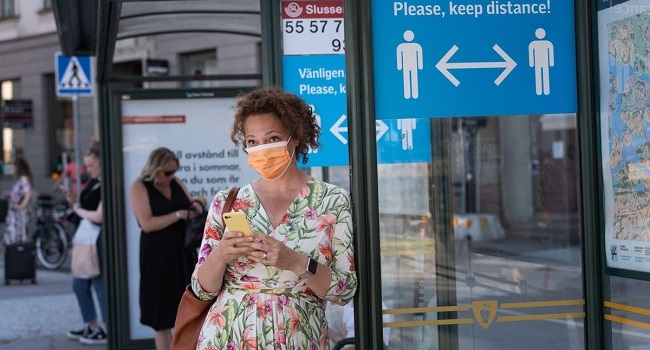Hailed by some but held up elsewhere as a cautionary tale, Sweden’s “softer” approach to curbing the COVID-19 pandemic has made headlines around the world.
Like other nations, the Scandinavian country has tweaked its strategy in recent months amid a second wave. Here is how things look now:
What is the Swedish strategy?
Judging it nearly impossible to stop the virus completely, Sweden’s authorities aimed to protect the elderly and risk groups.
Initially, they planned to allow the virus to spread slowly in society, at a pace that wouldn’t overwhelm healthcare services.
They neither imposed lockdowns nor closed schools for under-16s, and have always advised social distancing over mask-wearing.
Frequent hand-washing, working from home and staying home at the first sign of symptoms were also highlighted in calls on citizens to act “responsibly”.
April brought one of the only bans, ending visits to nursing homes at first nationally and later regionally as needed.
As the second wave took hold in October, the Public Health Agency and the government began issuing stricter recommendations, first in hard-hit regions and then nationwide as of December 14.
These include calls to avoid public transport and crowded stores, as well as limiting social interactions to single households or people already in regular contact.
In November, the government banned alcohol sales after 10 pm until February, and reduced the limit on public events from 50 to eight people.
Prime Minister Stefan Lofven has urged people to cancel all social engagements, and not go to the gym, library, shopping centres or other public places.
The government also ordered high schools to conduct classes online from December 7 until January 6.
Why did it adopt this strategy?
Public health authorities have insisted that battling the pandemic is “a marathon, not a sprint”, and measures have to be sustainable for the long haul.
In general, Swedes also have a high level of trust in authorities, and the government in turn greatly relies on expert agencies.
The strategy has therefore been guided by the Public Health Agency. It argued that draconian lockdown measures are not effective enough to justify the negative impact on society.
And unlike most other countries, Sweden does not have legislation that allows the government to shut down society in peacetime.
The government is therefore preparing a temporary, one-year “pandemic law” it aims to have in place by March 2021.
It would empower the government to limit the number of people in public places and regulate businesses and services by restricting opening hours, or even shutting them down.
How well has the strategy worked?
The effectiveness of the strategy has been fiercely debated, at home and abroad.
Sweden’s Covid-19 death toll is nearly six times the combined number in neighbouring Denmark, Norway and Finland as well as Iceland, all of which adopted stricter measures.
However, many other European countries that imposed lockdowns, such as France, Italy, Spain and Britain, have fared worse than Sweden’s 772.5 deaths per million inhabitants.
The government in May admitted it had “failed” to protect the elderly in nursing homes, where nearly half of deaths have been recorded.
On December 15, an independent commission concluded Sweden had failed in its effort to protect the elderly, though it also noted that some of this failure related to systematic flaws already present before the pandemic.
Outside nursing homes, Sweden’s “recommendations” have not always had the desired effect.
A December survey by the Civil Contingencies Agency showed nine of 10 Swedes said they were good at following the recommendations but a third were sceptical of others’ diligence — and the government has expressed frustration with those who don’t.
Prime Minister Lofven, who held a rare address to the nation in November after being accused of being absent in the crisis, said his government had been forced to step in and impose stricter recommendations during the second wave as Swedes were not behaving as responsibly as they had before.
Did Sweden pursue herd immunity?
Early on it was widely reported that Sweden’s goal was “herd immunity”, when a significant portion of the population has had the virus and developed antibodies, thereby stopping community transmission.
Swedish authorities have robustly denied this.
“No it’s never been a part of the strategy,” state epidemiologist Anders Tegnell told AFP in September.
However, allowing the virus to spread slowly leads to high immunity levels, he acknowledged.
“It’s good to have high immunity in the population… We are seeing the effects,” he told AFP in June when cases were in decline.
Emails between the Public Health Agency’s top officials obtained the by media have revealed however that the issue of herd immunity arose early on in their discussions on Sweden’s strategy.


